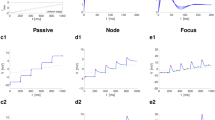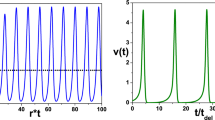Abstract
We present the conductance limit of the voltage–conductance model with random firing voltage when conductance dynamics are slower than the voltage dynamics. The result of the limiting procedure is a transport/Fokker–Planck equation for conductance variable with a non-linear drift which depends on the total firing rate. We analyze the asymptotic behavior of the limit equation under two possible rescalings which relate the voltage scale, the conductance scale and the firing rate. We provide the sufficient framework in which the limiting procedure can be rigorously justified. Moreover, we also suggest a sufficient condition on the parameters and firing distribution in the limiting conductance equation under which we are able to obtain a unique stationary state and its asymptotic stability. Finally, we provide several numerical illustrations supporting the analytic results.










Similar content being viewed by others
References
Brette, R., Gerstner, W.: Adaptive exponential integrate-and-fire model as an effective description of neural activity. J. Neurophysiol. 94, 3637–3642 (2005)
Brunel, N.: Dynamics of sparsely connected networks of excitatory and inhibitory spiking networks. J. Comput. Neurosci. 8, 183–208 (2000)
Brunel, N., Hakim, V.: Fast global oscillations in networks of integrate-and-fire neurons with long firing rates. Neural Comput. 11, 1621–1671 (1999)
Cañizo, J.A., Yoldaş, H.: Asymptotic behaviour of neuron population models structured by elapsed-time. Nonlinearity 32, 464–495 (2019)
Cáceres, M.J., Carrillo, J.A., Perthame, B.: Analysis of nonlinear noisy integrate and fire neuron models: blow-up and steady states. J. Math. Neurosci. 1, 7 (2011)
Cáceres, M.J., Carrillo, J.A., Tao, L.: A numerical solver for a nonlinear Fokker–Planck equation representation of neuronal network dynamics. J. Comput. Phys. 230, 1084–1099 (2011)
Cai, D., Tao, L., Rangan, A.V., McLaughlin, D.W.: Kinetic theory for neuronal network dynamics. Commun. Math. Sci. 4, 97–127 (2006)
Cai, D., Tao, L., Shelley, M., McLaughlin, D.W.: An effective kinetic representation of fluctuation-driven neuronal networks with application to simple and complex cells in visual cortex. PNAS 101, 7757–7762 (2004)
Carrillo, J.A., Perthame, B., Salort, D., Smets, D.: Qualitative properties of solutions for the noisy integrate and fire model in computational neuroscience. Nonlinearity 28, 3365–3388 (2015)
Chevallier, J., Càceres, M.J., Doumic, M., Reynaud-Bouret, P.: Microscopic approach of a time elapsed neural model. Math. Models Methods Appl. Sci. 25, 2669–2719 (2015)
Chiani, M., Dardari, D., Simon, M.K., Cooper, G.: New exponential bounds and approximations for the computation of error probability in fading channels. IEEE Trans. Wirel. Commun. 2, 840–845 (2003)
Dumont, G., Henry, J.: Synchronization of an excitatory integrate-and-fire neural network. Bull. Math. Biol. 75, 629–648 (2013)
Fourcaud, N., Brunel, N.: Dynamics of the firing probability of noisy integrate-and-fire neurons. Neural Comput. 14, 2057–2110 (2002)
Fournier, N., Perthame, B.: Monge–Kantorovich distance for PDEs: the coupling method. Preprint, hal-02080155 (2019)
Mischler, S., Weng, Q.: Relaxation in time elapsed neuron network models in the weak connectivity regime. Acta Appl. Math. 157, 45–74 (2018)
Pakdaman, K., Perthame, B., Salort, D.: Adaptation and fatigue model for neuron networks and large time asymptotics in a nonlinear fragmentation equation. J. Math. Neurosci. 4, 14 (2014)
Perthame, B., Salort, D.: On a voltage–conductance kinetic system for integrate and fire neural networks. Kinet. Relat. Models 6, 841–864 (2013)
Perthame, B., Salort, D.: Derivation of an integrate and fire equation for neural networks from a voltage–conductance kinetic model. Commun. Math. Sci. 17, 1193–1211 (2019)
Rangan, A.V., Kovacic, G., Cai, D.: Kinetic theory for neuronal networks with fast and slow excitatory conductances driven by the same spike train. Phys. Rev. E 77, 041915 (2008)
Sirovich, L., Omurtag, A., Lubliner, K.: Dynamics of neural populations: stability and synchrony. Netw. Comput. Neural Syst. 17, 3–29 (2006)
Acknowledgements
BP has received funding from the European Research Council (ERC) under the European Union’s c innovation programme (Grant agreement no. 740623).
Author information
Authors and Affiliations
Corresponding author
Additional information
Publisher's Note
Springer Nature remains neutral with regard to jurisdictional claims in published maps and institutional affiliations.
About this article
Cite this article
Kim, J., Perthame, B. & Salort, D. Fast Voltage Dynamics of Voltage–Conductance Models for Neural Networks. Bull Braz Math Soc, New Series 52, 101–134 (2021). https://doi.org/10.1007/s00574-019-00192-7
Received:
Accepted:
Published:
Issue Date:
DOI: https://doi.org/10.1007/s00574-019-00192-7




